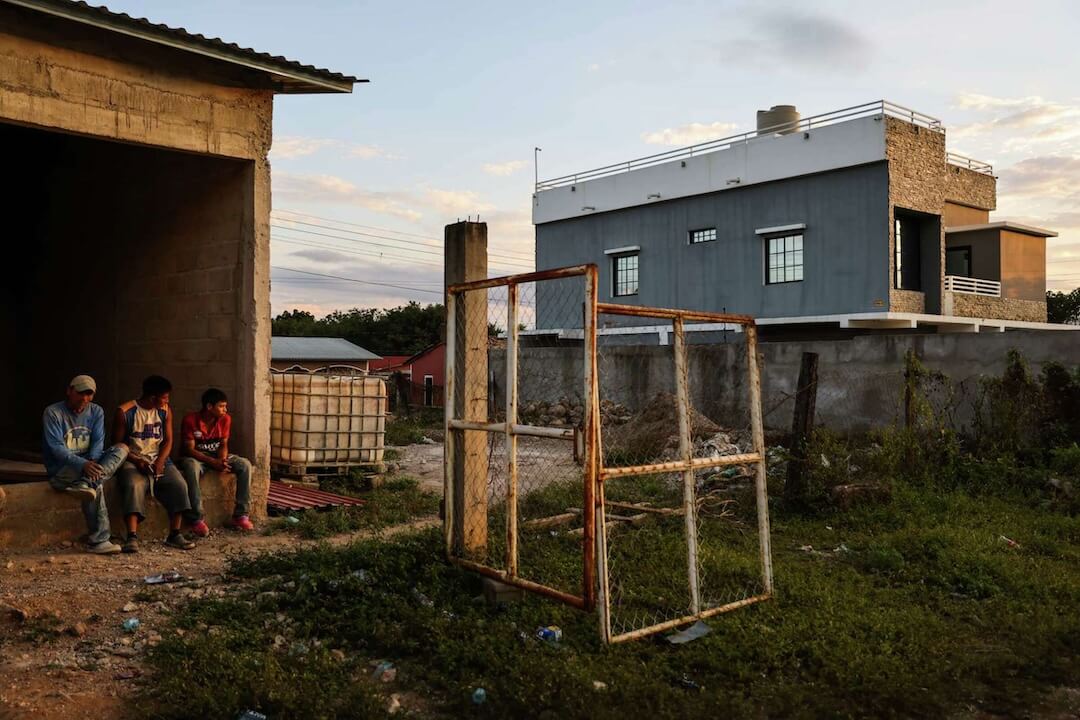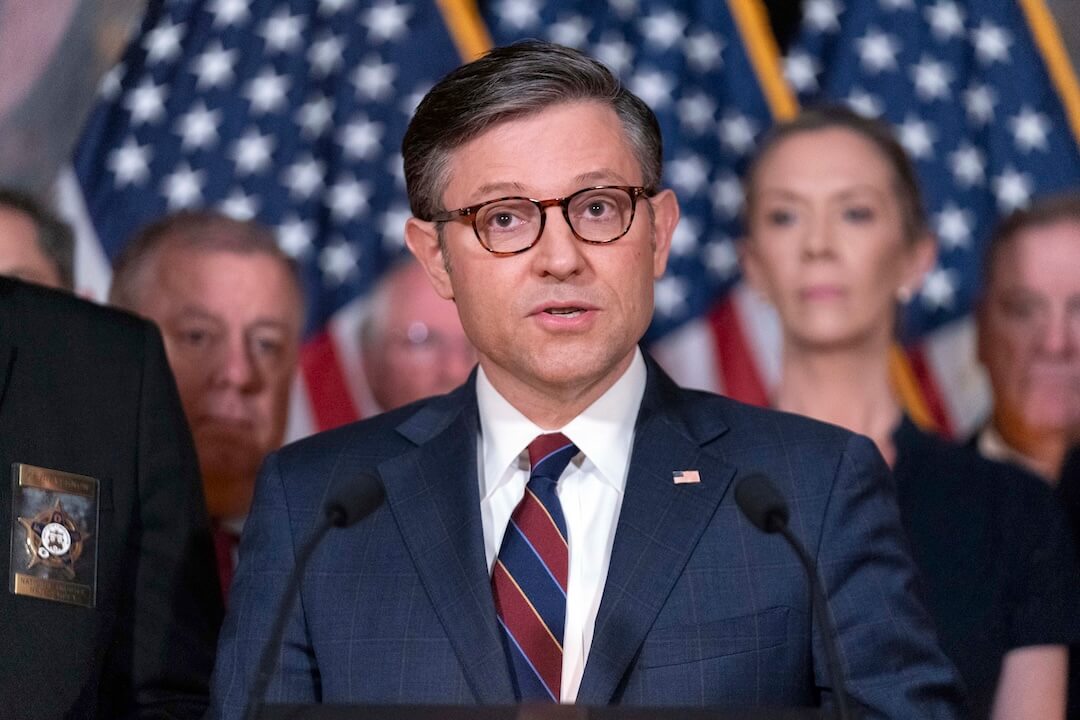Eighteen months into reporting on the pipeline of drugs from Honduras to San Francisco, Megan Cassidy and her reporting and photo partner Gabrielle Lurie had an abundance of vivid material. Street corner scenes of an all-but-open fentanyl marketplace in the Tenderloin. Interviews with surprisingly candid drug dealers in both San Francisco and the tiny towns in Honduras where most of the drugs come from.
It wasn’t until the very end of the process a return trip to a cluster of towns in the Siria Valley, though, Cassidy told me, that she found what would be the lead to their Poynter Prize-winning project. “I had been concerned whether we were accurately describing (the places where the top dealers lived) as mansions rather than just really big houses.” She decided, yes, they were mansions.
On this visit much more than their first, the San Francisco Chronicle team saw San Francisco icons everywhere — kids in Steph Curry T-shirts, logos of the Warriors, 49ers, and Giants on gates and stores, even a bas relief of the Golden Gate Bridge on a garage door.
Drug running was the main industry in the Siria Valley; so its residents paid tribute to their sister destination city as a second hometown.
After a colorful rendering of the look and feel of towns in the Siria Valley, the lead story in their project reverted to a crisp, bare style. The facts did not need dressing up; there were few adjectives or adverbs. The Poynter Prize judges awarded the project, “Probing San Francisco’s drug trade,” the Deborah Howell Award for Writing Excellence. They commented, “The anecdotes chosen to tell the story are straightforward and searing, including … vibrant scenes of the humanitarian disaster that drugs have created in the city’s Tenderloin neighborhood.”
The judges also observed that it was a case in point of the axiom that “impactful writing starts with exceptional reporting.”
The Deborah Howell Award recognizes distinguished achievement in writing in any medium and comes with a $2,500 prize sponsored by Advance Publications, Inc.
Beat crime reporter Cassidy considers herself a reporter first, not a writing stylist. But in the end, she became immersed in the writing discipline.
“Our editor, Emilio Garcia-Ruiz, drilled this one into me throughout the writing/ editing part of the story. Show don’t tell. Show don’t tell. My default way of writing is to paraphrase the reporting’s findings (tell) and then to back that up with examples (show). Many, many paraphrased grafs were killed during the making of this story. … There was a cold war between me and Emilio. … I fought to keep (many of) them in, but he was right.”
I asked Cassidy to walk me through how the project took shape, both the reporting and the writing. It turned out to be quite the tale.
It started soon after Garcia-Ruiz, previously the top digital editor at The Washington Post, began as the Chronicle’s editor-in-chief in the fall of 2020. He had been hearing about the Honduran connection from both his staff and others he met and quickly became an advocate for the project. I asked Cassidy if that mirrored The Boston Globe’s investigation of sexual abuses in the Catholic Church in 2002, commissioned by new editor Marty Baron and later memorialized in the movie “Spotlight.”
“Totally,” she said, “It was exactly that. … A lot of us knew about it (the Honduras connection). … We had always wanted to do something. Emilio saw the potential right away.”
Photographer Lurie, who has been a Pulitzer Prize finalist twice for photos of drug dealing in the city, was on board from early on. In fact, she took a lead in framing the pitch. The two women’s personalities meshed into an effective team, Cassidy said. “She pushes more than me,” and moved the project ahead when the reporting encountered lulls.
“At the beginning, we were willing to set the bar low,” Cassidy said. “We weren’t so sure that any drug dealers would talk. … We thought maybe you can find a priest” as a source who knew the drug scene in detail.
Cassidy was eager but also skeptical. “That’s where Gabrielle played a big role. Being sent out of town, I was nervous that we would get there and sit on our hands.”
They did hit dead ends — ditched when they arrived for some promised interviews, told of a key town that turned out not to be involved at all.
However as the persistent digging continued, the pair eventually hit a reporting jackpot. It turned out the drugs were not flowing to San Francisco from all over Honduras, Cassidy said, but instead all came from the same cluster of small towns.
The team suddenly knew “right, right where to go.”
In Honduras and back in the States, they ultimately landed 25 interviews of current and retired dealers, many willing to be quoted by name.

Winston Guerrero, a former dealer who migrated from Honduras, says he was inspired to quit selling and using drugs after talking to his nephew, Jacob Rodas López (right). (Gabrielle Lurie/San Fransisco Chronicle)
While the reporting did not involve bullets flying over their heads, they worked in high-danger zones. In one town, a gang war had been going on. They engaged security and stayed elsewhere, leaving the town by early afternoon.
Three months before the publication date, Cassidy undertook the unfamiliar task of pulling together her vast store of material. “It went through so many iterations … the first draft was nothing like the final,” she said.
At one point, she recalled being more than a little intimidated when she and Lurie got called to “a big, high-level meeting … big easels all around the room.” That yielded a way of organizing, she said — as much as possible letting the eyes and words of the dealers tell the story in sequence.
It also became clear that some strong material did not fit well in the main stories and ended up broken separately into two sidebars. The first was a long interview of a woman ending a term in prison, talking about her role and how the drug trade operated. The other profiled a current, anonymous dealer (with the qualifier that he might have been embellishing in spots).
While the scenes of the drug dealers stand out, the authors artfully wove in more conventional topics:
- The political context in which Mayor London Breed was accused of leniency on drugs and homelessness. (She was voted out of office earlier this month.)
- The geography of the pipeline. The drugs were actually manufactured in Mexico. Honduran mules did some of the treacherous smuggling into the U.S.; Honduran dealers, the street sales.
- A few of the drug workers were trafficked, as their defense lawyers have claimed. Most were freely drawn to the money they could make after living in dead-end poverty. They knew San Francisco was a sanctuary city, but came because they knew others who were prospering there rather than because it was a lenient environment.
They harvested what data was available to document the extent of the problem. But compared to a typical big investigation, Cassidy said, there was not much of it and the court records “were super dry and lacking much substance or detail.”
That may have been a blessing in disguise, tilting what they wrote and illustrated. “99% of the world we were trying to explain lives outside of anything that’s officially documented,” she added, so the balance naturally tilted in another direction.
On a first read of the project, I was struck by how integral Lurie’s photographs were to the storytelling. There were many of them, and they were paced to match an adjacent point in the text.
When the forerunner awards of the Poynter Prizes were conceived 45 years ago, all of them were for writing, and there was no regard for how they were illustrated. The internet has largely erased those lines.
Lurie explained to me via email how she saw her contribution. “The reporting was about ‘showing’ and was often observational. It wasn’t just based on interviews but what we were seeing in real time. We knew that I would need photographs of the mansions and details of the San Francisco iconography. We also wanted to have the human elements and worked very hard to get consent from people for that. I had so many images that will never see the light of day but would have also worked well with the text.
“Ultimately, Megan and I were very in sync, and she was respectful of what I needed so we were able to balance images and reporting. We knew certain elements that were needed and went back to Honduras a second time to ensure we had those…
“Executing the images both in Honduras and here in San Francisco was extremely tricky. In Honduras, I mostly photographed from car windows unless I was invited into someone’s home. A couple of times I stepped out of the car and men who were highly armed quickly approached me to intimidate me.
“In San Francisco, I struggled even more. I photographed from undercover police cars (with tinted windows), apartment buildings and parking garages. Sometimes if it felt right, I’d be outside in plain sight, but that was rare.”
Even though danger was not a constant in reporting the project, Cassidy agreed, it never was that far away. Apologizing for a potentially sexist question, I asked whether two women might have been in particular peril taking the assignment and courageous to do it.
“Our editors gave us a lot of credit for that,” Cassidy said, “but they also said we were the two most qualified people.”
And maybe there were advantages to being a woman in the circumstances, she has reflected. “A man getting out of the car might have looked more intimidating,” more likely to have drawn an armed response.
Given the pair’s commitment, I was also not surprised to learn that even after the project was published in July 2023 and on its way as an entry to contests, their involvement in the story was not over. This February, Cassidy and Lurie shared a byline with one other reporter on three dealers being brought back from Honduras to stand trial in San Francisco.
***
Eugene Patterson, as editor of the St. Petersburg Times, was the president of the American Society of Newspaper Editors and creator of these prizes in 1979. Patterson, an extraordinarily graceful writer himself, thought there were already many prizes for great investigative reporting but none where the focus was on writing. The prizes have evolved and were moved in 2023 to Poynter as ASNE dissolved. The Deborah Howell Award, which Cassidy and Lurie won, is one among 10 prizes still specifically for writing excellence.
Here are two excerpts from the Chronicle’s entry, the first from Honduras:
One afternoon last November in El Pedernal, a village of 1,600 residents, a longtime San Francisco dealer on a visit home rested on his balcony as he oversaw about a dozen workers laying concrete for his new driveway. The unnamed dirt roads below him vibrated with hammers and buzz saws as crews assembled the new homes of his neighbors.
The three-bedroom home occupied by his wife and children cost him $150,000 — the equivalent of about five good months of drug sales for him in the Tenderloin — but he marveled at the grandeur of some of his neighbors’ properties.
“A little boy, 17 years (old), he built this house,” the dealer said, pointing to a mansion under construction. “You open the door — beautiful.”
And from San Francisco:
On a weekday afternoon in June, a man in his early 30s lay motionless on a SoMa sidewalk outside the Federal Building. On his right, a dozen users smoked fentanyl and crack cocaine or hung bent at the waist, heads suspended at their knees. To his left, a handful of dealers, cloaked in black but for the space around their eyes, continued selling while a passerby revived the man with Narcan, the nasal-spray antidote to opioid overdoses, and as paramedics arrived to treat him a few minutes later.







Comments